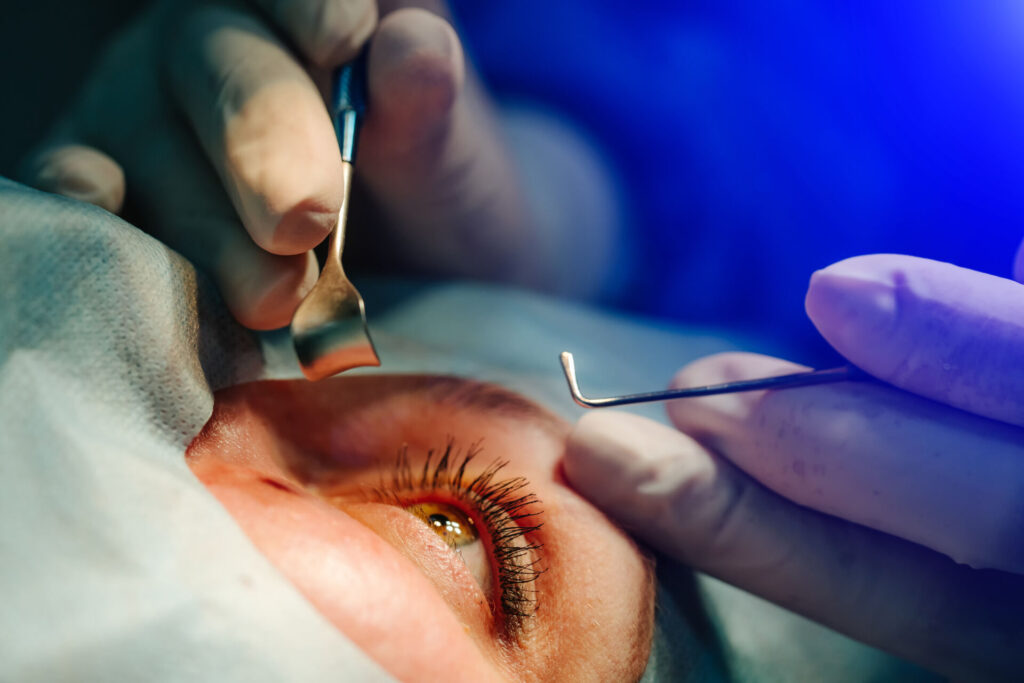Last month, we discussed hyperopia, or farsightedness, and some signs that may indicate when someone is suffering from this common refractive error. While hyperopia, the inability to clearly see nearby objects, is less common than myopia, it is common in older patients and generally worsens with age.
Mild hyperopia is commonly corrected with eyeglasses or contact lenses. As the condition progresses, however, surgical options may be preferred to restore clear eyesight. One of the most effective is lens exchange, a procedure in which the natural lens in a patient’s eye is replaced with an artificial intraocular lens (IOL).
In this article, we’ll dive into the advantages and disadvantages of lens exchange and what you can expect from a lens exchange procedure.
What Is Lens Exchange?
Replacing the eye’s natural lens with an artificial lens is a common procedure. It’s frequently used as a surgical remedy for cataracts – and the procedure for lens exchange to correct hyperopia is identical to cataract surgery.
Replacement lenses come in two main types:
- Multifocal lenses, which can improve both your near and far vision but have an increased risk of optical side effects.
- Monofocal lenses, which only correct one range of vision – in the case of hyperopia, they will typically correct only near vision. Patients with monofocal lenses may still require eyeglasses or contacts for seeing objects very close or far away.
In some cases, ophthalmologists will recommend a “monovision” replacement, in which two different monofocal lenses (one focused for near vision, one focused for distant vision) are implanted, one into each eye.
In all cases, the surgeon will use numbing drops to deaden the sensation in the eye. Then, a small incision will be made on the eye’s surface, and a special tool will break up the existing natural lens and remove it from the eye. Finally, the new artificial lens is inserted into the eye. The incisions involved in a lens exchange are tiny and don’t require any stitches. They’ll close and heal on their own.
The procedure takes about 15-30 minutes per eye. If you’re having both lenses exchanged, they’ll be done during two different surgeries, usually 2 to 3 weeks apart.
What Are the Advantages of Lens Exchange?
- For individuals with severe hyperopia, lens exchange can mean complete or near-complete freedom from corrective lenses. About 80% of patients no longer need corrective lenses after surgery.
- Artificial lenses are not susceptible to cataracts, eliminating a common threat to an aging patient’s eyesight.
- Lens exchange is highly successful, with nearly 95% of patients reporting satisfaction with the surgery’s outcome.

What Are the Possible Side Effects of Lens Exchange?
Lens exchanges are very safe, but as with any surgical procedure, there are some side effects and the risk of complications:
Short-term, Expected Side Effects of Lens Exchange
The following side effects are commonly experienced after lens exchange and will typically stop after a few days:
- Blurred vision
- Double vision
- A “gritty” sensation in the eye
- Bloodshot or red eyes
- Watery eyes
- A “shadow” in your peripheral vision
- An arc of shimmering light in your peripheral vision
- Halos or glares around lights, especially at nighttime
Potential Complications of Lens Exchange
There are a few complications that can arise following a lens exchange. Most of them can be corrected, but if you begin to experience symptoms of any of these conditions, contact your eye doctor immediately:
- Retinal detachment: Blurred vision, a “curtain” over your vision, flashes of light in your eyes, or the sudden appearance of many “floaters” in the eye could indicate a detached retina.
- Vision loss: A worsening of your eyesight or any degree of vision loss.
- Capsular rupture: A break in the membrane that holds the lens. This complication can usually be corrected while the lens exchange is happening or may require you to make a second visit to repair the membrane.
- Capsular opacification: Also called a “secondary cataract,” this is a clouding of the membrane that holds the lens. It can occur months or even years after your lens exchange and can be corrected with a non-invasive laser procedure.
Preparing for and Recovering From a Lens Exchange
There’s very little preparation required for a lens exchange procedure. Once you and your eye doctor have decided which type of lenses will be best for you, you may be given a short list of steps to take before the surgery; these will vary depending on your eye care provider. In some cases, there may be no real preparatory steps to take – just show up for your appointment.
Following the procedure, aftercare will consist primarily of some eye drops to speed up the healing process. Healing completely from the procedure could take as long as eight weeks, but you should be able to resume your normal lifestyle within a few days, up to a couple of weeks. Your doctor will tell you how long you should wait before:
- Driving
- Returning to work
- Swimming
- Engaging in other physical activities (strenuous activity and contact sports will typically be limited for a longer period)
Once your recovery is over, you will undergo an eye exam to determine the procedure’s effectiveness, and then you can enjoy your new, clearer vision of the world around you!
If You Have Severe Hyperopia, Clear Vision May be Within Reach With a Lens Exchange Procedure. Call Eyesight Associates and Schedule Your Exam Today!
Our team has seen exceptional results from lens exchange procedures to correct farsightedness, nearsightedness, and cataracts. Give us a call to learn more: 478-923-5872.
Related Articles:
